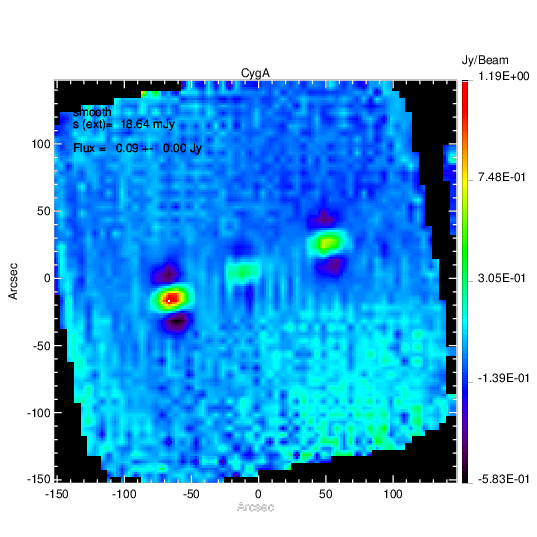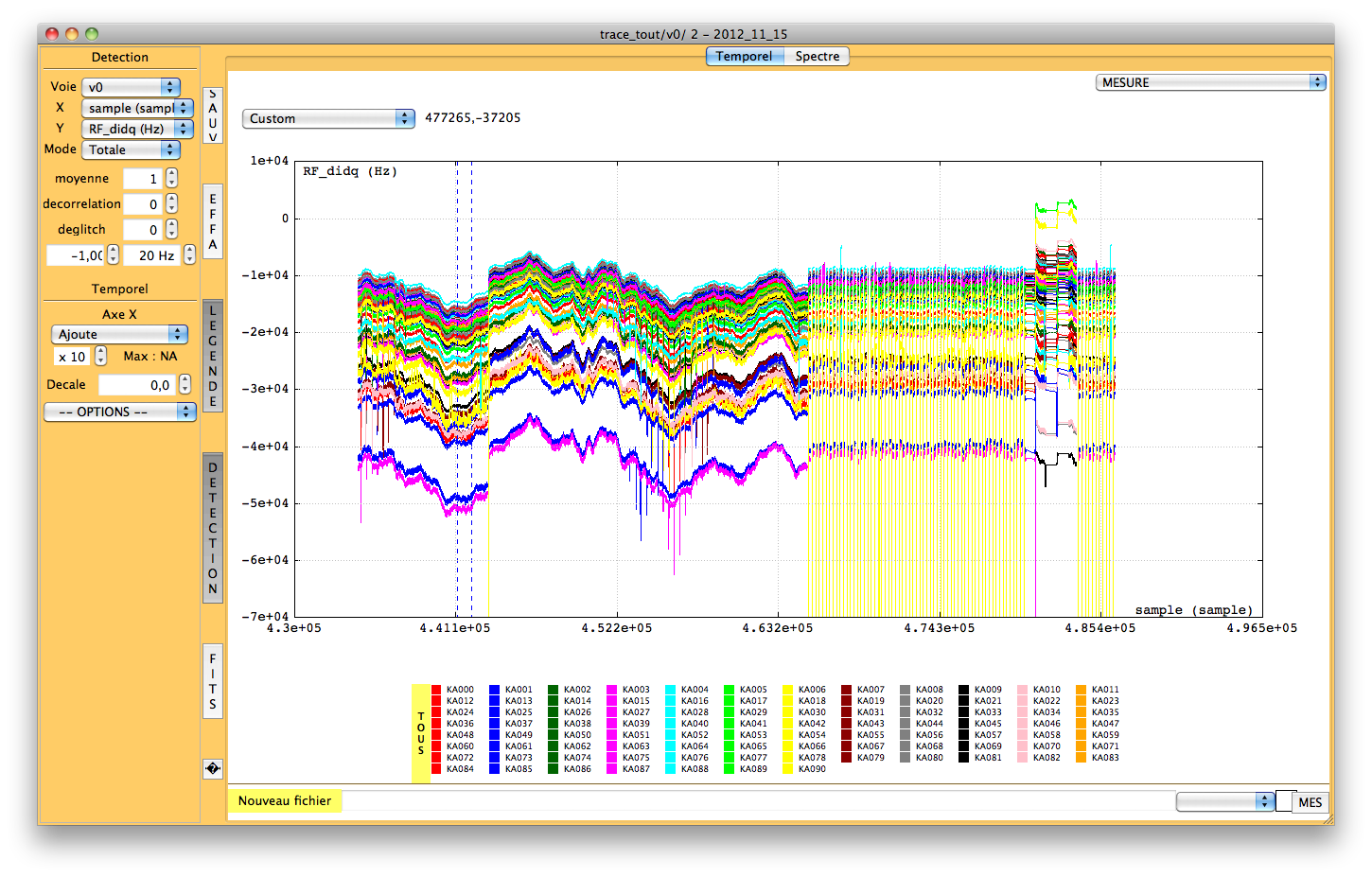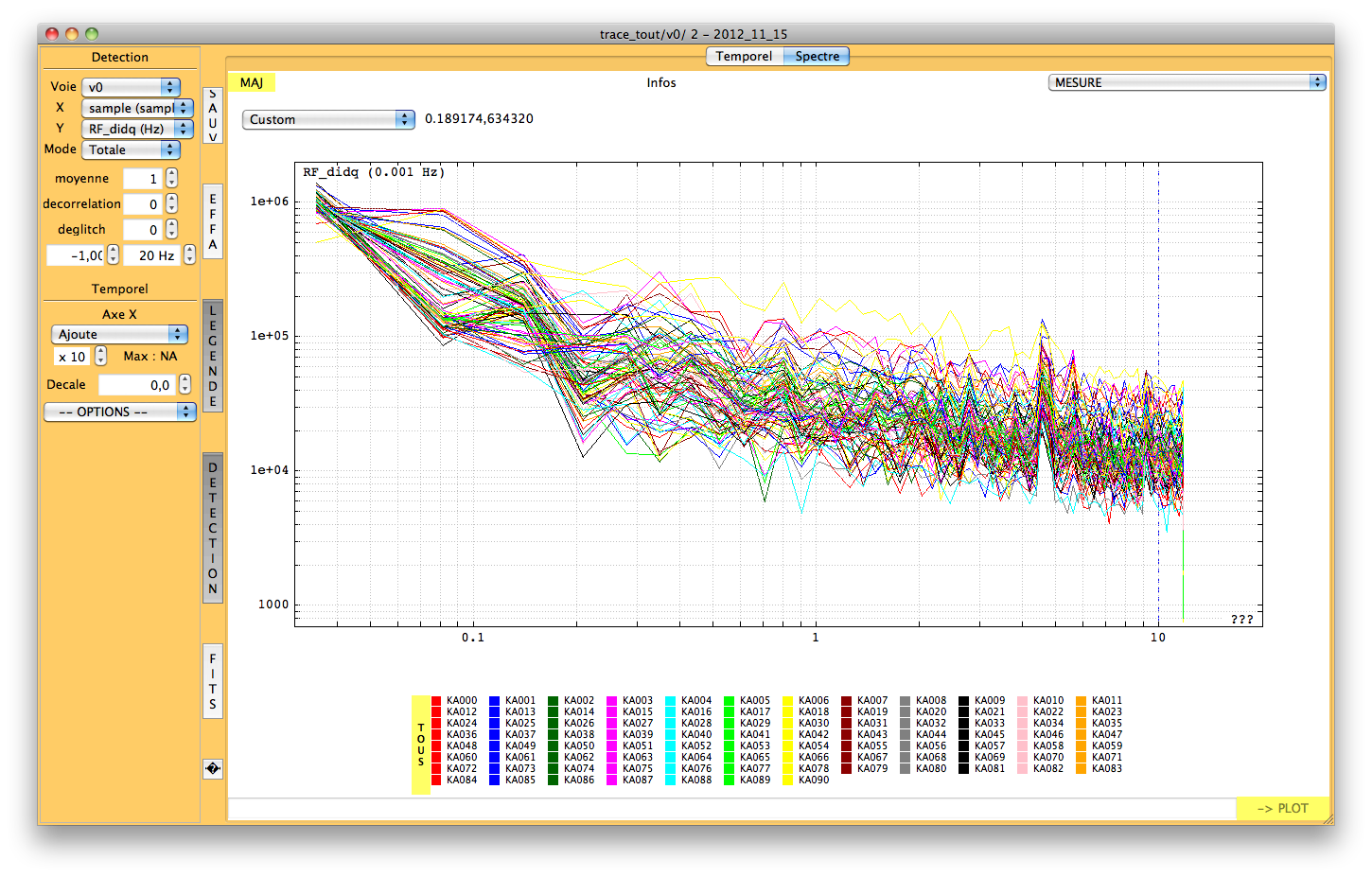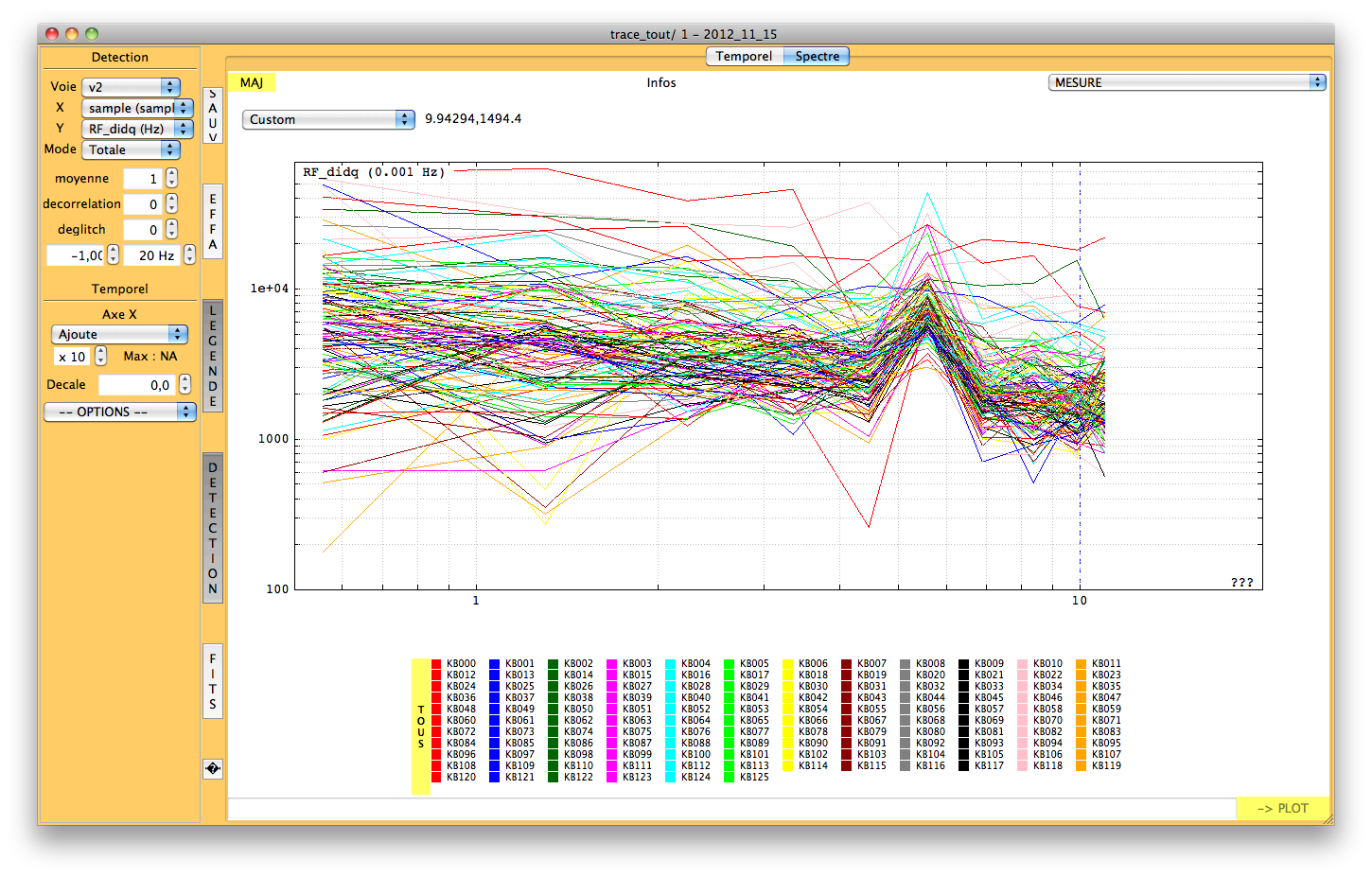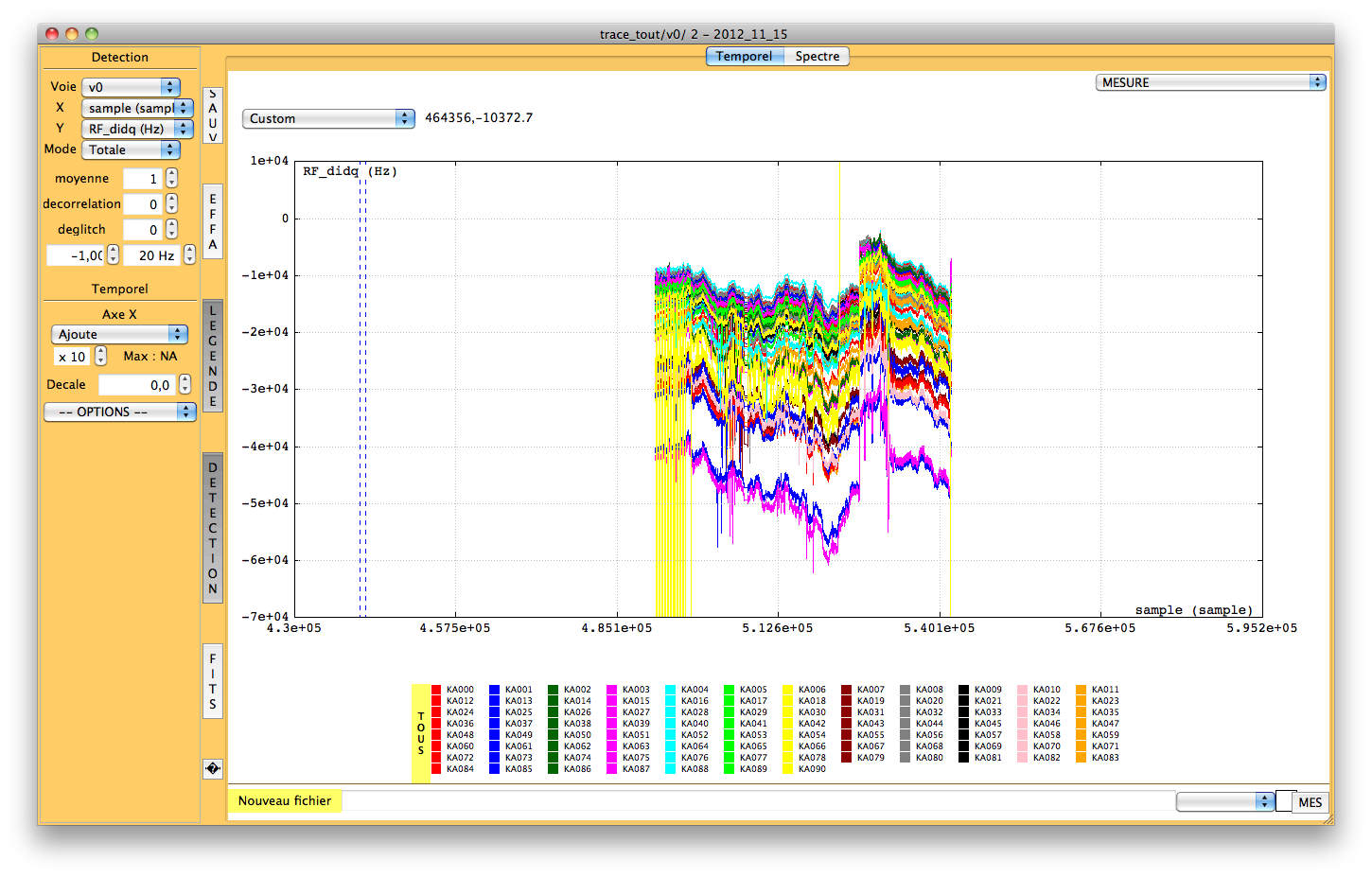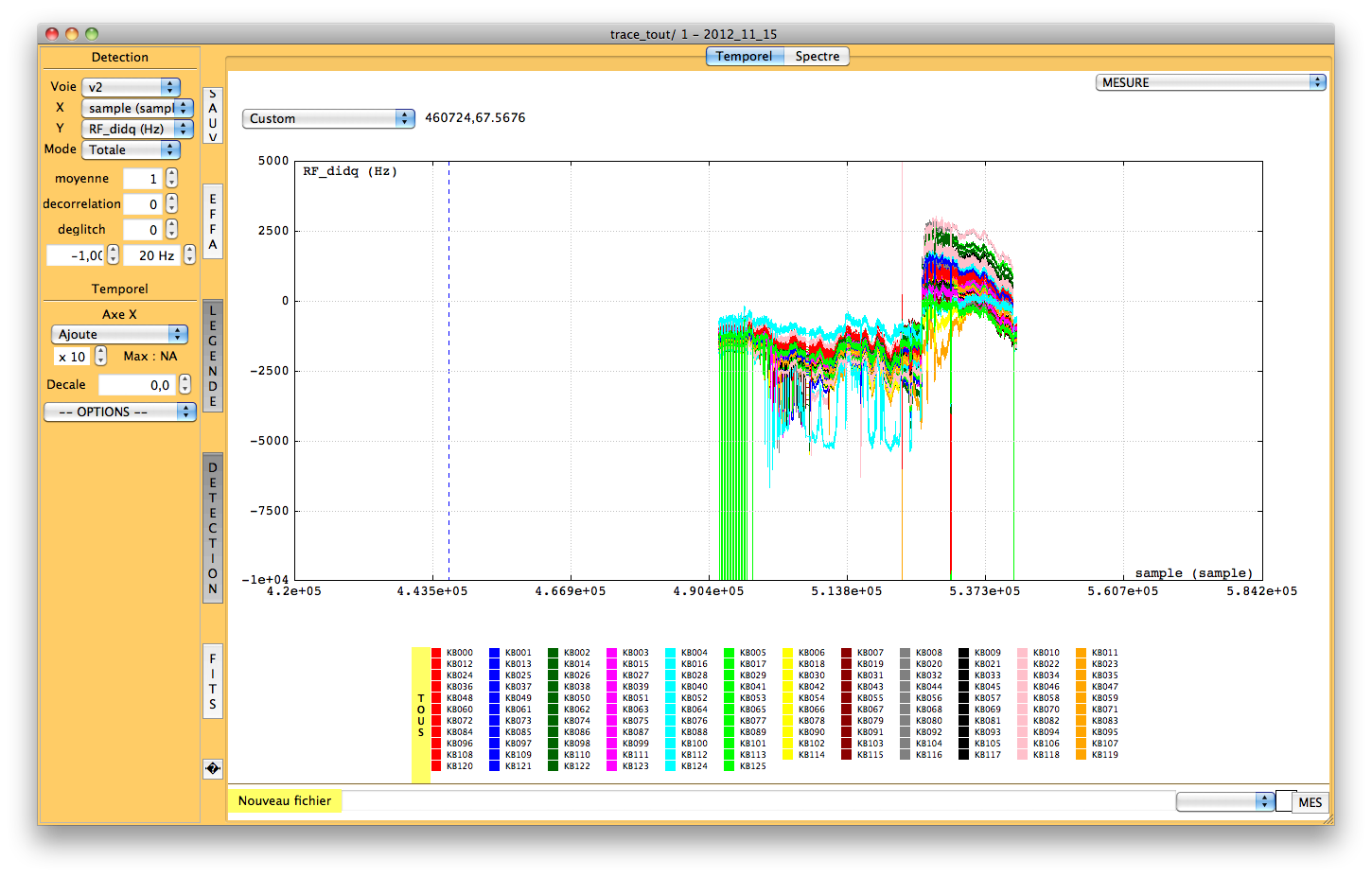|
Size: 19206
Comment:
|
Size: 19390
Comment:
|
| Deletions are marked like this. | Additions are marked like this. |
| Line 229: | Line 229: |
| {{attachment:uranus_all.png||width=800}} | {{attachment:uranus_all.png||width=500}} |
| Line 236: | Line 236: |
| Line 237: | Line 238: |
We can now run real time analysys of OTF scans on weak sources. Here is an example on CygA at 2mm (Flux scale to be settled yet). {{attachment:CygA_smooth_W2.png||width=500}} |
Daily reports
Strategy for editing the page: the anti-chronological order makes it difficult to follow updates and discussions for someone not following the updates in real time when the latest entry answers an older entry possibly difficult to find. So we go back to CHRONOLOGICAL ORDER and use the table of content with hyper links to avoid long scroll downs
Contents
Thursday 8 November 2012
Alessandro and Martino driving from Grenoble to Granada with the electronic equipment (NIKEL et al.)
Friday 9 November 2012
Cryocooler started. Unfortunately the 3He pumps makes very strong vibrations in the cabin possibly affecting GISMO observations; that was not a problem as long as the weather was to bad for observations, but the forecast was good for the night, so we stopped the pump in the evening. Hopefully the pump is not mandatory for the 1st phase of the cooling process.
Saturday 10/11
The NIKA cooldown is not suffering from the pump stop. The inner parts of the cryostat are also cooling down in some way. At mid afternoon the cryostat is below 8K. However we can start the dilution only if the 3He pump is switched on. If the weather degrades again so much that the observations with GISMO are not possible any more we will switch on the pump, otherwise we have to wait until Tuesday.
Alain and Juan have been testing the NIKA software remotely, sneaking the Elvin messages from the GISMO observations.
Sunday 11/11
Snow; GISMO can't observe, so we turned on the 3He pump in the morning to proceed with the cooling process. The 3He-4He dilution started in the afternoon. ~250 mK near midnight.
Monday 12/11
Martino and Alessandro reached the telescope this morning. The cryostat is cooling down slowly but with no apparent problems. Temperature is 180mK at 1pm roughly. Expected to reach 100mK overnight. The plan in case we have to switch off the 3He pump and reduce vibrations on GISMO is to stop injecting (close eV3), stop the pump and open eV10 leaving the mixture to slowly (we hope as slowly as possible) go back in the reserve.
Tuesday 13/11
De-installation of the GISMO electronics, cryogens, installation of the NIKA electroncis, laser alignment, switch on everything. In the evening, NIKA is cold, start to look at the behaviour of the resonances. Problem: impossible to see the 1mm array ! Work till 3am to investigate the problem, make hypotheses and tests.
Wednesday 14/11
We feared the feed line was broken on the 1mm array or something else that necessitate to warm up and open the cryostat to fix the problem. We organised an emergency trip for Andrea to bring spare arrays, amplifiers, mixers, etc. In the mean time Martino found the problem: something must be broken in the IQ mixer; it delivers a 4GHz harmonics >10000 time stronger than the tones ! We could use a low pass filter so that everything higher than the band of the tones (which is 2 to 2.5 GHz) is cut, or better, we could change the mixer. In both cases it won't be necessary to open the cryostat (ouf !). Until the spares arrive we can still get the resonances of the 1mm array by reducing the power on the LO. Not great but good enough to see the resonances.
Our first hours on the sky were a bit tedious. Test various observing scripts, many little things to change in the various software, to handle, merge and format the data correctly. We gave back the telscope 2.5 hours in advance of the schedule so that Juan Penalver can do an unscheduled pointing cession with EMIR, we have enough data anyway to work and be ready for tomorrow.
Cryostat regulated at 200mK (+/- 0.02mK) for today. Heating power 105uW.
Thursday 15/11
Changed other things on the 1mm (e.g. added an old isolator at input to further kill the 2nd LO harmonics). Way better that yesterday (barely seeing Mars !), but not yet optimal (noise at meast 2-3 times worse than expected. But usable. Found 90 reasonable pixels. 126 pixels on the 2mm.
Started observations at 17h. Still not possible to do the pointing model.
Noise on 2mm array roughly 2Hz/sqrt(Hz) for most pixels (assuming decorrelation works, as is usually the case). Signal on Neptune (6.5Jy at 2mm) was around 600Hz, so S/N is roughly 300. If we trust that is 20mJy/sqrt(Hz) per pixel on 2mm. This is further confirmed on Uranus (18Jy at 2mm), for which the signal is around 2kHz. The cosmetics also does look nor bad. Out of 126 pixels, by eye, I'd say 2 thirds are good.
Concerning the 1mm array, a bit less nice. Noise is roughly 20Hz/sqrt(Hz) .. say between 10 and 20 in good weather. Signal on Uranus (50Jy) is 5000-10000 Hz. Thus S/N say between 500 if you're pessimistic and 1000 if you're optimistic. That means 50-100mJy/sqrt(Hz) per pixel. Same thing seen on Mars (in that case, due to very low elevation, we applied a correction very approximative). So I'd say (Alessandro) it's not more than 2 times worse than usual. We'll see tomorrow. We're waiting for Andrea with the new mixers. Could be that the amplifiers we added to boost I and Q on the up-converting side add some noise. Andrea arrived at 20h with the mixers.
|
|
Response on Uranus is 5-10kHz on the 1mm array (left) and 2-2.5KHz for the 2mm (right). Response is thus: 100-200 Hz/Jy at 1mm and 100-125 Hz/Jy at 2mm.
|
|
Noise as seen here is 10-20Hz/sqrt(Hz) for 1mm array and 1.5-2Hz/sqrt(Hz) for 2mm. Assuming the low-frequency part is correlated (TBC). A line at 4.6Hz is most probably coming from something in the cabin (appearing and disappearing).
|
|
Radiometric alignment performed by moving M5 in two directions. Gained roughly 2K in terms of background, for tau=0.1 sky.
Cryostat regulated at 150mK (+/- 0.02mK) for today. Heating power 50uW. SEEMS A GOOD COMPROMISE FOR BOTH ARRAYS.
Friday 16/11
The new mixers did not improve things significantly. Since the sensitivity at 1mm seemed not too bad we continue in the same configuration. Started observing at 17h LT, roughly 1 hour to test sky-dip routines. Then we go to Neptune but the sky gets very bad (at 2mm jumping by up to 100Jy). Telescope stopped for wind, started again at 20h15. Good news is that the "auto-tuning" (tuning every 10 seconds while "not in scan") procedure works very well in bad sky too. Only have problems with extreme sky-dips (going to EL<20deg) and when stopping the telescope (closing vertex). Observation stopped basically from 19h to 22h30 at least
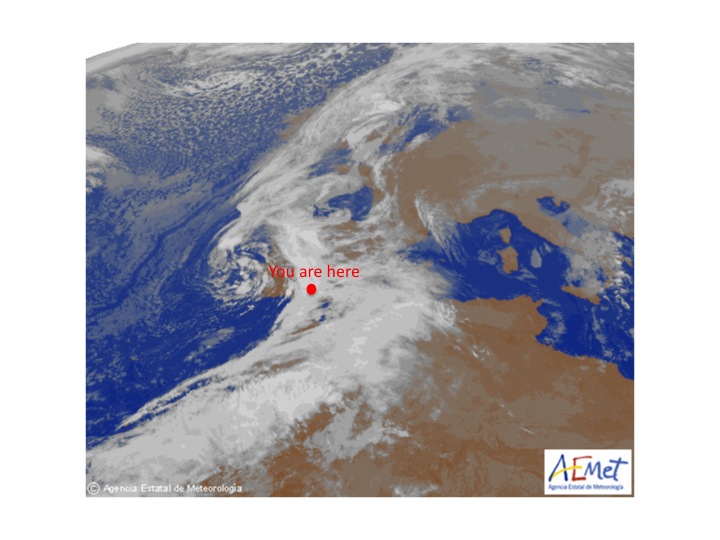
Saturday 17/11
Snow. No observations. We thus played a bit to try optimize the 1mm. We have created a "param" with only 8 pixels, but those pixels have the nominal power of -50dBm per tone (the one tested in Grenoble and that gave the best results). We confirm that the noise is as expected (around 5Hz/sqrt(Hz)). Thus, the amplifier is just saturating, but not broken. And the arrays should behave with nominal sensitivity. We'll thus have the choice between two times more noise (power -62dBm per tone) but 90 pixels or nominal noise but 8 pixels (-50dBm per tone). The 90 pixels will be used for real observations, but we want to demonstrate a nice sensitivity at 1.25mm with the 8 pixels configuration, if possible. That should be the final array sensitivity once we've solved the amplifier saturation. And demonstrate the KIDs have no intrinsic problems in reaching the sensitivity for NIKA-2.
Sunday 18/11
Snow in the morning. Clearing then.
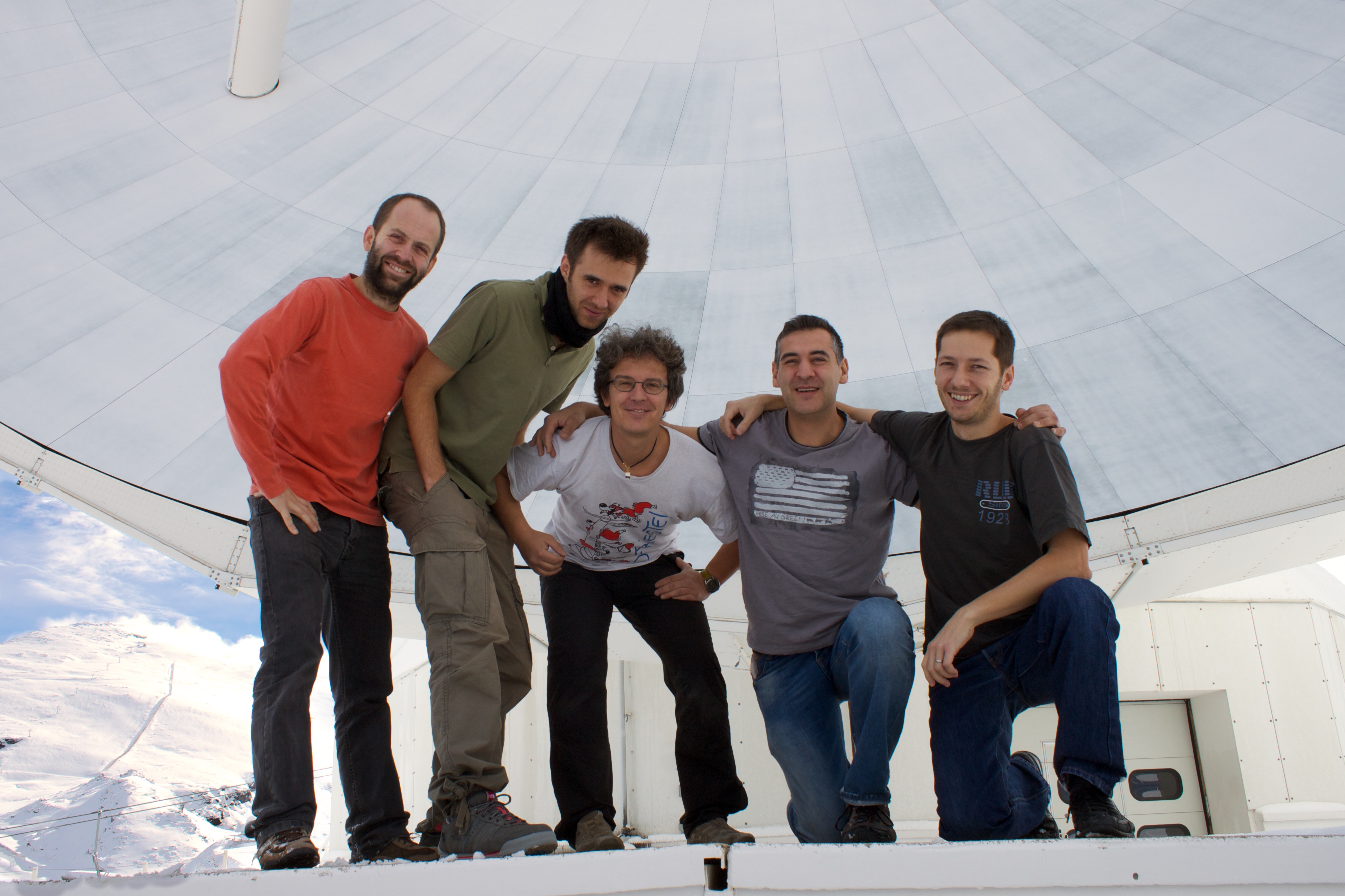
First Sun.
Update many pages of the wiki:
Alessandro check off-line: identified roughly 80 good (noise < 3Hz) pixels out of 126 on the 2mm array (beams to be checked). Means 2/3.
Plan for tonight (126 pixels 2mm, 8 pixels 1.25mm good noise):
UTC 16h source mars; track 200 200; OTF_geom; Cross; Focus; Cross (corrected). Goal: resonances and geometry on Uranus again. Results: 3kHz at tau=0.3
UTC 17h30 source pointing_quasar; track 200 200; Cross + Focus + Cross (corrected).Goal: Correct pointing before source
UTC 18h00 source IRC 10420; track 200 200 ; 2 x OTF_faint. Goal: 460mJy at 1mm
UTC 18h30 source pointing_quasar; track 200 200; Cross + Focus + Cross (corrected). Goal: Correct pointing before source
UTC 19h00 source WR147; track 200 200 ; 3 x OTF_faint. Goal: around 100mJy at 2mm
UTC 20h00 source pointing_quasar; track 200 200; Cross + Focus + Cross (corrected). Goal: Correct pointing before source
UTC 20h30 source MWC349; track 200 200 ; 2 x OTF_faint. Goal: 1.5Jy at 2mm; secondary calibrator
< UTC 21h00 pointing session until 23h
OPTIONAL: source GMaur; track 200 200 ; 6 x OTF_faint. Goal: 70mJy at 2mm
Reminder: a 100mJy source gives a signal of 10-20Hz at 1mm and 10-12.5Hz at 2mm.
Monday 19/11
Xavier and Alexandre arrived this morning.
Plan for tonight (126 pixels 2mm, 90 pixels 1.25mm):
UTC 16h00 source neptune; track 200 200; Cross; Focus; OTF_geom. Goal: start run
UTC 17h00 source uranus; track 200 200; Cross; Focus; 3xOTF_geom. Goal: three geometries with DIFFERENT FOCUS +/- 1mm
UTC 18h00 source K3_50A; track 200 200; Cross; 2xOTF_faint Az-El. Goal: Secondary calibrator
UTC 18h15 source MWC349; track 200 200; Cross; 2xOTF_faint Az-El. Goal: Secondary calibrator
UTC 18h30 source W3OH; track 200 200; Cross; 2xOTF_faint Az-El. Goal: Secondary calibrator
UTC 18h45 source CRL 618; track 200 200; Cross; 2xOTF_faint Az-El. Goal: Secondary calibrator
UTC 19h00 sky-dip session; manual + DIY
UTC 19h15 source uranus; track 200 200; OTF_geom. Goal: test different DAC level -6dB; plateau
UTC 19h30 source FTtau; track 200 200; 4xOTF_faint Az-El-Az-El. Goal: faint point-like source (50mJy)
UTC 20h00 source DRtau; track 200 200; 4xOTF_faint Az-El-Az-El. Goal: faint point-like source (50mJy)
UTC 20h15 source GMaur; track 200 200; 4xOTF_faint Az-El-Az-El. Goal: faint point-like source (60mJy)
UTC 20h30 source 4C05.19; track 200 200; 12xOTF_faint Az-El-Az-El.... Goal: faint point-like source (10mJy)
UTC 21h30 source DR21OH; track 200 200; OTF_15x10 Az-El Goal: extended source
UTC 22h15 source Crab; track 200 200; OTF_15x10 Az-El Goal: extended source
ATTENTION: Juan's model has been calculated using the relative pointing offsets measured during the pointing session thinking these was absolute offset. For example the 1st cross relative offsets are (-1.33;1.36) but the absolute ones are (8.47-1.33;11.09+1.36). Tomorrow Juan will implement a new pointing model based on the correct offsets.
ATTENTION: At the beginning of the session we forgot to change the reference pixel (when we point a source it is centered on that pixel); so we used the pixel 454 of the 2mm array, but it has no 1mm counterpart, so none of the 1mm array pointing are usable ! Don' t forget to change the reference tomorrow; choose either pixel 432 of the 1mm array or pixel 33 of the 1mm array which are close to each other on the sky, or, pixel 414 of the 2mm array or pixel 8 of the 1mm array which are also close to each other on the sky, and in all cases they are all quite close from the center of the arrays.
ATTENTION: Sky-Dip, test-plateau (DAC level), DR21OH and GMaur not performed due to timing.
Tuesday 20/11
Vincent Reveret and Nicolas Billot arrived this morning. Alessandro, Nicolas P., Samuel left this morning
Plan for tonight (126 pixels 2mm, 90 pixels 1.25mm):
We are organized in 8h shifts 0-8 8-16 16-24
Start earlier than schedule (maintenance is finished and no Emir pointing session) (Bullets are finished sequences)
- T=1h Pointing model update + change of reference pixel to numdet=(8, 414) Cross-focus-OTFgeomfast
- T=1h Plateau study: OTF geometry fast on Mars then with lower power (-6dB)
- T=1/2h OTF geom fast on Neptune (to test linearity and calibration)
- MWC349 Secondary Calibrator: Cross then OTF_faint_source_Az, then El
- If mediocre weather: DR21 Cross, then DR21(OH) OTF_10x10_faster_Az, then El.
If OK weather: faint source program : Cross on pointing quasar then 50 min on a faint source with OTF_faint_source_Az, then El, etc...See here
- UT 24: skydip in two ways (to be prepared for midnight): First the diy-test-12.pako, alternatively
- UT 1h: Deep survey on HAT084933: First Cross on pointing quasar: OJ287 (backup 3C273) then OTF_DS_Az, El ...
- UT 4h: SZ on MACS0717 First: Cross on 0923+392, then OTF_SZ_Az, OTF_SZ_El,...up to 8h UT
- UT 8h: SZ on RXJ First: Cross on 3C279
- UT 12h: DR21 (if not already done, see above)
- or M87, in OTF_faint_source...(Cross on 3C273 first) for 1/2 hour M82, in OTF_DS mode (Cross on B0954+658 first) for one hour CygA, in OTF_DS mode (Cross on CygA itself) for 1/2 hour Arp220, in OTF_faint source mode (Cross on 3C345) for 1/2 hour NGC1068 in OTF_faint_source mode (Cross on ALFORI+ OTF_faint_source because Second. Calibrator)
- UT G34.3, K3-50A, MWC349 Secondary calibrators: Cross, OTF_faint_source_Az, El
Wednesday 21/11
- Weather was rather bad during the night and windy but we could observe all time. Opacity is improving in the afternoon (~0.3).
Plan for the next 24h.
- UT 14h: Test the new pointing model based on the new reference pixels (8, 414) and data acquired yesterday evening. Mars (Cross, focus, geom) then 3 pointing sources or more to check.
- 15h: Cross+faint_source_Az on Neptune
15h30: LKH234 Secondary calibrator: Cross, FaintSource
- 16h: SMMJ2135 faint_source Az, El for 2 hours, To be preceded by : Pointing with a cross on G45.1 or 1749+096 then one faint_source_Az
- 18h15: Uranus Cross focus Geom.
- 18h45: PSS2322+1944 faint_source Az, El for 2 hours, To be preceded by : Pointing with a cross on 3C454.3 then one faint_source_Az
- 20h30: CasA 10x10
- 20h45: Skydip: diydown and diyup
- 21h30: MACS0717 (see yesterday)
1h30: NGC2023 idem OTF_10x10Az + El (Pointing Cross on Alfori+FaintSource)
- 3h: GN20 Deep field. Every two hours Cross on pointing quasar: 1144+402 (backup 1308+326), then OTF_DS_Az, El ...
- 8h: RXJ (see yesterday)
- for tomorrow: Fomalhaut 1h30 Faint_source Az, El (pointing quasar to be found, try 2210-257 in iram-J2000)
During the evening, a power supply failure has shut down the pulse tube for 3/4h as well as the whole nasmyth cabin. The team (with Alain the ghost being everywhere, Martino and Andrea) has reacted quickly. The recovery has worked out and observations can resume around UT:23:30 (T<200mK). The origin of the problem is not yet clear.
Thursday 22/11
We solved the mystery: what is the best tau meter: tau or lambda? Here you have our first sky dip with a decent fit obtained with the brand new (J-M-FX routines). The values for tau0 at 1 and 2 mm are 0.43 and 0.43/2.0 respectively. We have used two independent skydips going down and going up.
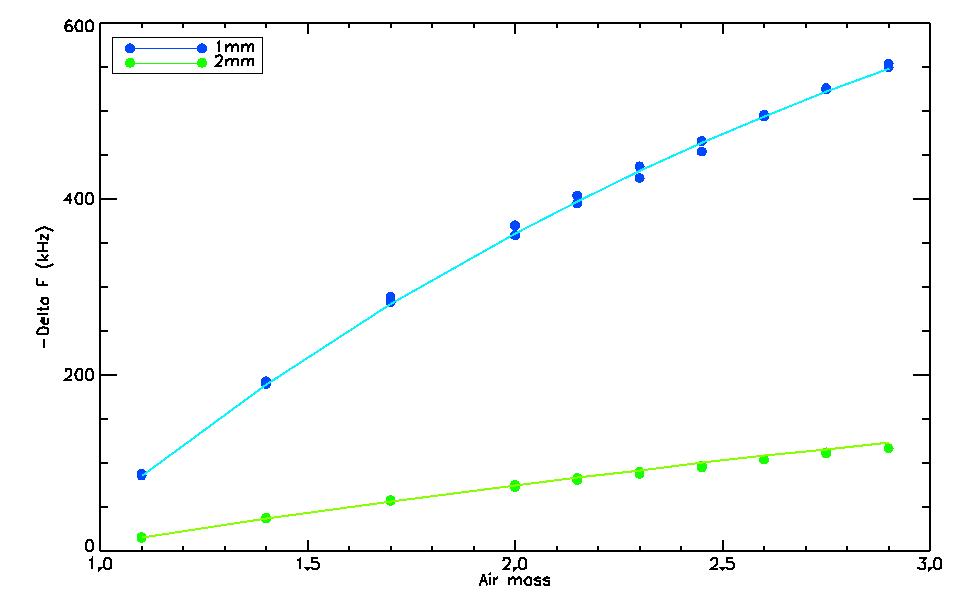
Alessandro. Sorry but not 100% clear to me: it's tau or lambda the right one ?
Answer: Tau (Classical)=0.64 and Lambda =0.42. Lambda seems closer? (FX-JMP) Currently, we have two 225GHz taumeters running, the old and the new one, lambda is the zenith opacity measured by the old taumeter, but what is tau(classical) ? (CK) The tau(classical) is the value we read on the same screen at the top. So confusing! We plan to repeat the skydip tomorrow (Please ignore the "tau" of the old taumeter, but rather compare NIKA skydips with "lambda" of the old taumeter. Bare in mind that the old taumeter does not have a calibration unit and may drift. (CK))
Had problems with wiki. wiki updates could resume only Friday (thanks to Nicolas Billot and Pablo for solving that). Logbook was manual (handwriting in the old way). Wiki will be filled tomorrow.
Weather has become submilimetric in the afternoon. After some fog came around, the sky noise was much reduced (beginning of the evening).
Friday 23/11
Weather keeps being submillimetric (tau<0.1, humidity at 0% and temperature at 2degC).
Plan for the next 24 hours: after RXJ, Skydip, IDCSJ1426, Mars, ..., SXDF
Alessandro. You know already that, but just a reminder after discussion with RZ, NP, SL this morning at Grenoble: a) always follow a "focus" by a "cross" to check the correction improved actually the beam; b) when possible perform the "focus" a bit more often.. at that time two crosses before and after don't hurt; c) don't forget to make from time (every few hours ?) maps on stronger/calibrated sources, as post-run beams consistency check.
Doing perpendicular cuts to determine the best focus position is nice, and this is how we do it with single-pixel heterodyne receivers. With NIKA, we could however study a map, and hence the entire beamshape. Doing this with GISMO, we found indications that focus was slightly off in x and y. (CK)
Already done, see e.g. http://www.iram.es/IRAMES/mainWiki/OffProcNika3, RZ, 25 Nov 2011 - Pointing & focus effects, and the display of (almost) each focus processing by MOPSIC (until the NCS/IMBfits system was screwed up on Nov 20) (RZ)
A first beam map is obtained on Uranus (Alexandre Beelen) by upgrading BOA
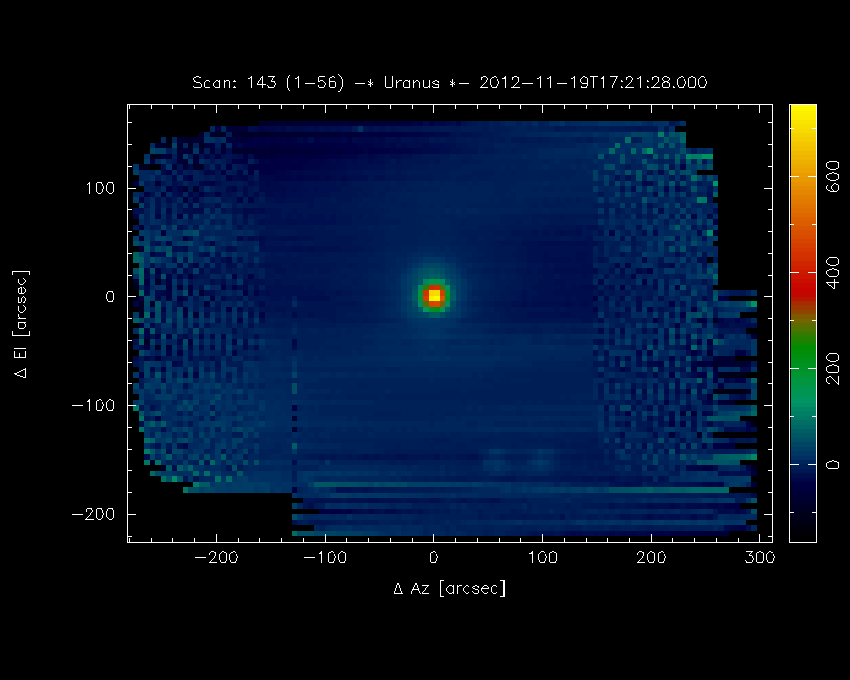
Nicolas Ponthieu has worked hard on the Real Time processing, here is an uncalibrated map of MWC349 a 2Jy Galactic source:
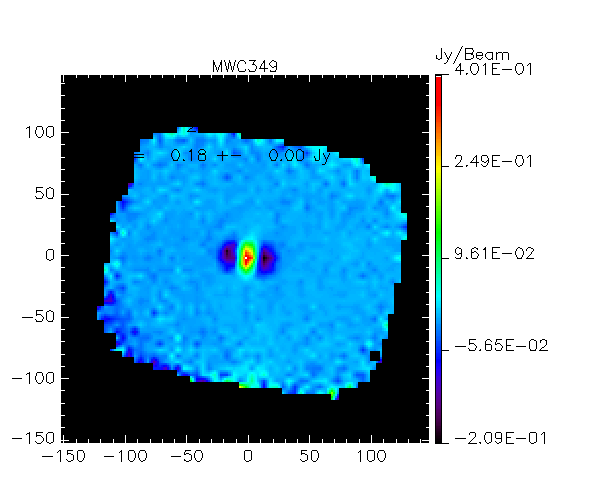
Note the FWHM of the 1mm channel (below 12 arcseconds on Uranus):
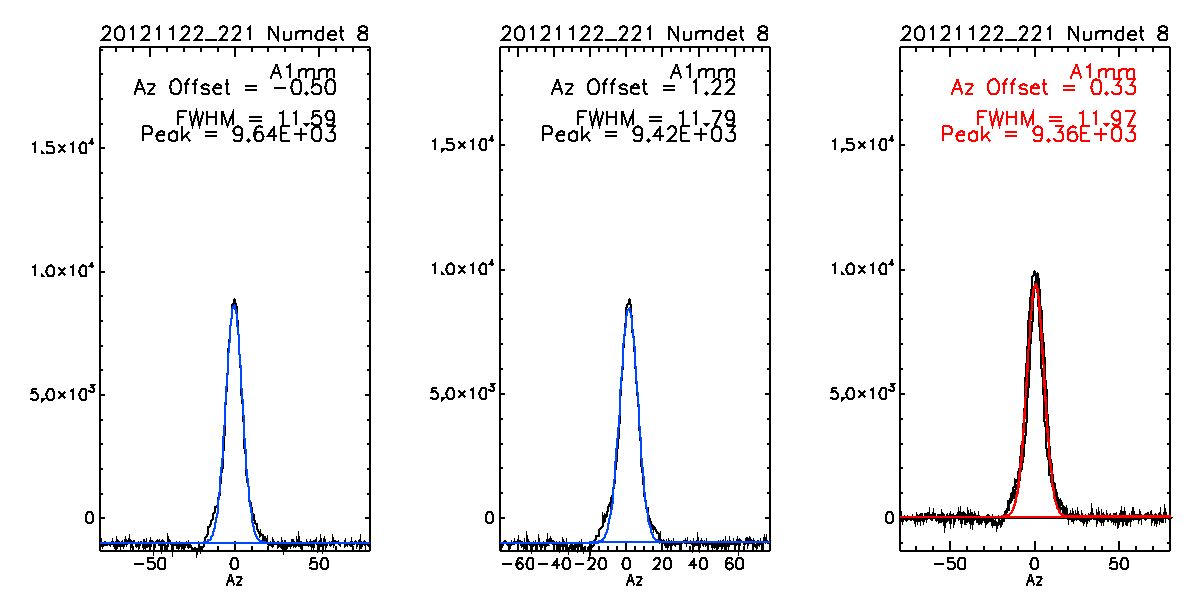
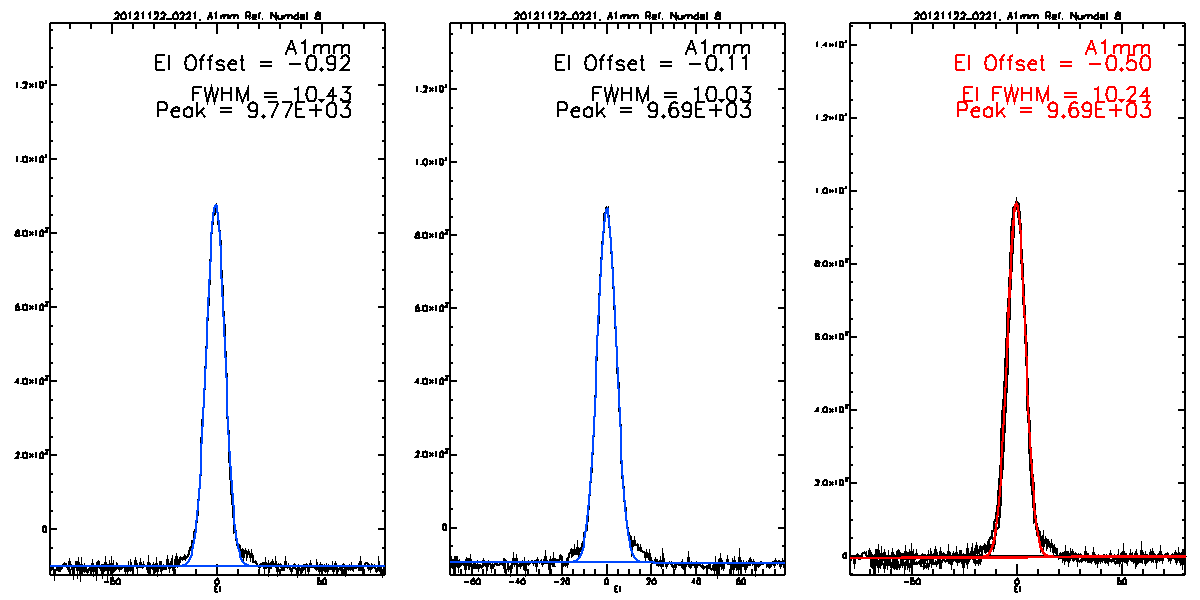
We can now run real time analysys of OTF scans on weak sources. Here is an example on CygA at 2mm (Flux scale to be settled yet).
